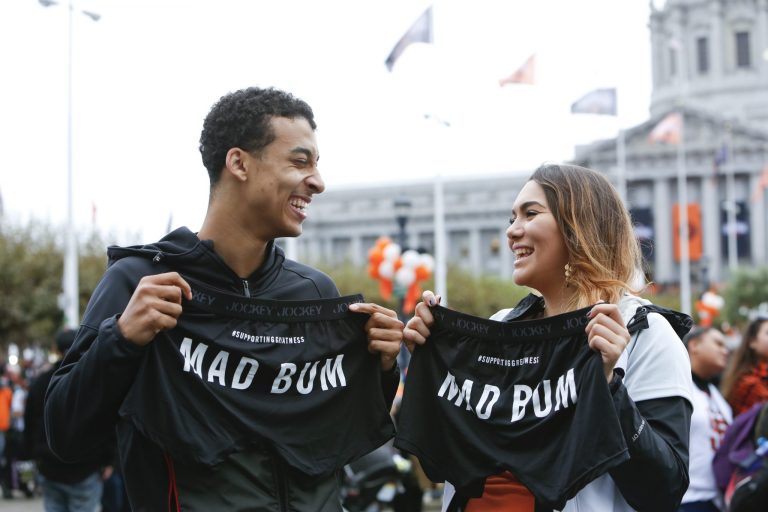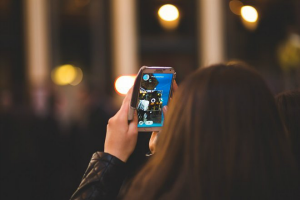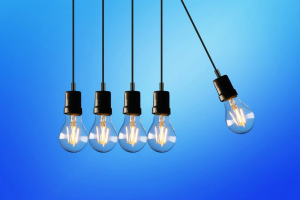08.31.18
By Lisa Major

Over the past several years, face-to-face marketing has proven itself to be one of the most effective marketing strategies around. And, experiential marketing is no longer just a trend, it’s here to stay. We’re kicking off this week’s edition of Happy Hour with a great article showcasing 10 statistics from around the world that prove just how powerful face-to-face marketing is. We also feature articles about how augmented reality is elevating brand experiences, trade show booth design tips, the science behind social media sharing, and the importance of human connections in technology-driven experiences.
“Experience has moved beyond a trendy buzzword to become an integral piece of the marketing pie.” ~Freeman XP
 Face-to-face marketing provides value for both consumers and brands. For starters, this type of marketing humanizes a brand in the consumer’s eye and forges a bond between the two. Experiences give consumers what they want and what they crave – a real-life, authentic connection. Brands can nurture those connections to gain valuable insight on what consumers want and need, and in turn, use that insight to gain new customers and create brand loyalists. If your management team is on the fence about incorporating face-to-face marketing into your advertising strategy, here are 10 key statistics that prove the power behind it all.
Face-to-face marketing provides value for both consumers and brands. For starters, this type of marketing humanizes a brand in the consumer’s eye and forges a bond between the two. Experiences give consumers what they want and what they crave – a real-life, authentic connection. Brands can nurture those connections to gain valuable insight on what consumers want and need, and in turn, use that insight to gain new customers and create brand loyalists. If your management team is on the fence about incorporating face-to-face marketing into your advertising strategy, here are 10 key statistics that prove the power behind it all.
“Consumers may still be holding artificial intelligence at arm’s length, but when it comes to augmented reality, they’re finally welcoming the technology with open arms.” ~Kait Shea
 The goal of experiential marketing is to create positive connections that foster long-lasting relationships between brands and consumers. And when brands fully engage with consumers by not only telling their story but also by immersing them in the story, it forges an even deeper bond. One of the most effective ways to do this is with augmented reality. While AR has been a hot topic in experiential marketing since Pokemon Go took the world by storm in 2016, most people didn’t fully grasp what the future meant for AR in the industry. Fast forward to 2018 where the “question is no longer if brands will find a way to seamlessly incorporate AR into their events, but how.” Here, Event Marketer shares five ways brands can use augmented reality to elevate live experiences.
The goal of experiential marketing is to create positive connections that foster long-lasting relationships between brands and consumers. And when brands fully engage with consumers by not only telling their story but also by immersing them in the story, it forges an even deeper bond. One of the most effective ways to do this is with augmented reality. While AR has been a hot topic in experiential marketing since Pokemon Go took the world by storm in 2016, most people didn’t fully grasp what the future meant for AR in the industry. Fast forward to 2018 where the “question is no longer if brands will find a way to seamlessly incorporate AR into their events, but how.” Here, Event Marketer shares five ways brands can use augmented reality to elevate live experiences.
“Consumers must perceive branded content as content that, if shared, will provide them with positive feedback from their followers, and therefore trigger the release of dopamine in the brain.” ~Rita Mogilanski
 In last week’s Happy Hour, we featured an article about the science behind experiential marketing, this week, we take a look at the science of social media sharing. With so much fake news, fraudulent ads, and fraudulent companies floating around on the internet, it’s no wonder why people are losing trust in companies. Today’s consumers trust their peers and influencers more than they trust brands, in fact, this article shares that 92% of consumers trust an influencer more than an advertisement. Getting people to share content and create buzz for your brand is one of the most impactful ways to reach consumers. This is why it is so important for brands to understand the logic behind social sharing to ensure they are creating an authentic shareable experience. This article features valuable information about how you can create shareworthy content.
In last week’s Happy Hour, we featured an article about the science behind experiential marketing, this week, we take a look at the science of social media sharing. With so much fake news, fraudulent ads, and fraudulent companies floating around on the internet, it’s no wonder why people are losing trust in companies. Today’s consumers trust their peers and influencers more than they trust brands, in fact, this article shares that 92% of consumers trust an influencer more than an advertisement. Getting people to share content and create buzz for your brand is one of the most impactful ways to reach consumers. This is why it is so important for brands to understand the logic behind social sharing to ensure they are creating an authentic shareable experience. This article features valuable information about how you can create shareworthy content.
“With rising competition and more complex booths than ever, you need to find an edge that will draw a crowd.” ~GES
 Trade shows draw thousands of attendees each year. And each year, exhibitors at these trade shows are bringing in more creative and complex exhibit booths. Trade show exhibitors today are faced with some serious competition. A boring sign and brochures just don’t cut it anymore. The exhibitors that see the most visitors, generate the most leads, and gain the most social impressions, are the one who use compelling visual displays, and incorporate interactive and immersive elements into their booth design. Here are 8 tips on how to design a trade show exhibit that will help you reach your goals and boost your results.
Trade shows draw thousands of attendees each year. And each year, exhibitors at these trade shows are bringing in more creative and complex exhibit booths. Trade show exhibitors today are faced with some serious competition. A boring sign and brochures just don’t cut it anymore. The exhibitors that see the most visitors, generate the most leads, and gain the most social impressions, are the one who use compelling visual displays, and incorporate interactive and immersive elements into their booth design. Here are 8 tips on how to design a trade show exhibit that will help you reach your goals and boost your results.
“We have a tendency to build big sets and put on big shows with big surprises at every corner. Shock and awe is certainly an effective brand experience strategy, but equally effective in the surprise and delight category are sometimes just the simple moments.” ~Jonathan Ronzio
 The foundation of experiential marketing is based on human contact. Face-to-face interactions that drive moments that people will remember. Add technology to the experiential mix, and marketers have been able to elevate the consumer experience in ways we never imagined, reach broader audiences through social media, collect more leads, and even prove event ROI. But with these technology driven-experiences, have we lost sight of what matters most? The human connection? The great thing about experiential marketing is that marketers can have the best of both worlds. They can “harness the power of technology to craft [human] moments in the traditional, face-to-face space.” Here, Cramer talks about the importance of building experiences that blend both worlds, using technology to draw people in, but then offering simple moments, and distraction-free zones that allow them to really connect with other attendees and your brand.
The foundation of experiential marketing is based on human contact. Face-to-face interactions that drive moments that people will remember. Add technology to the experiential mix, and marketers have been able to elevate the consumer experience in ways we never imagined, reach broader audiences through social media, collect more leads, and even prove event ROI. But with these technology driven-experiences, have we lost sight of what matters most? The human connection? The great thing about experiential marketing is that marketers can have the best of both worlds. They can “harness the power of technology to craft [human] moments in the traditional, face-to-face space.” Here, Cramer talks about the importance of building experiences that blend both worlds, using technology to draw people in, but then offering simple moments, and distraction-free zones that allow them to really connect with other attendees and your brand.
Each week, ATN’s Happy Hour delivers the latest news in the event marketing industry. Join us next week for even more insights, tips, trends, and news. Cheers to the start of college football season and to a long holiday weekend!